Gold Jewellery of Ancient Style
Thai traditional goldsmith craft emphasizes on the value of idea and immaculate workmanship in the creation process. Time, concentration and special skills of each technique are required to complete this one-of-a-kind piece. Most traditional gold works therefore cannot be promptly produced as an instant response to demands. Enthusiasts of this hand-crafted gold works thus remain a few. Each specific ancient design often uses combined techniques through several successive production stages. These long-inherited original designs usually have particular auspicious meanings believed to be beneficial to owners associated with them.
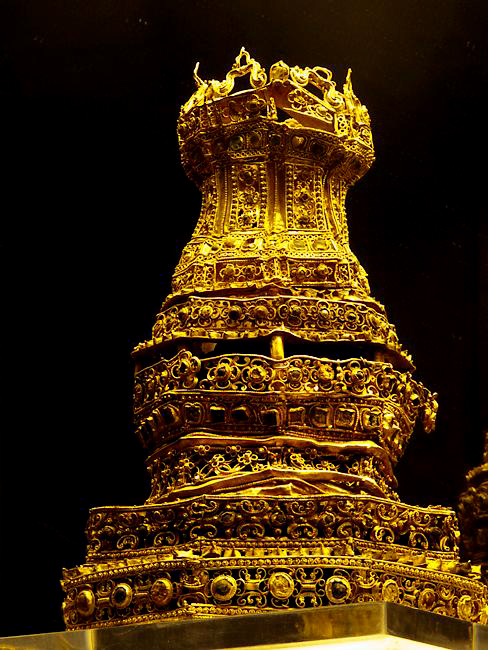
Gold has generally been treasured by people on this land of Suvarnabhum . Virtually all countries in the world have been using this precious metal as production material for utensils, apparels, body ornaments, venerated statues, decorative articles for high class architecture, as monetary substitute in trade, and as foreign exchange reserves, etc. Thai people use gold in many aspects of their daily life. Gold is even included in several formulas of Thai traditional medicine for example, Ya-hom which is a major common household remedy for dizziness and nauseating symptom. Some Ya-hom formulas add gold leaves in the medicinal mixture while the medicine spheres are sealed with gold leaves in the other. Additionally, gold is directly used as decorative ingredient for high class desserts such as Thong-eke and Ja-mongkut . There is also indirect use – borrowed in many derivations to name persons, trees, desserts and places, let alone provinces and districts which are abundant, for instance
Suphan buri,
Kanchana buri, Ang
thong , U-
thong ,
Kanchana dit,
Thong phabhum, Jom
thong , Wang
thong , Phon
thong , Pho
thong , Phan
thong , Bor
thong , Noan
suvarn ,
Suvarna bhum, Bangbua
thong , Rong
khum , Lumplai
mas , Chiang
khum ,
Suvarna -kuha,
Thong sankan,
Khum khuan-kaew, etc.
It seems Thai people always have gold in their subconscious mind. No doubt Thai expressions, proverbs and figures of speech are plentifully associated with gold, for example ‘Don't ever rub gold at tiles', ‘Speech is two Phai-bia , silence is Tumlueng of gold' (the two words being the lowest and highest of Thai ancient denomination), ‘Gold as thin as a shrimp's antenna in possession, be startled from sleep that the house sways', ‘Loose gold as big as one's head, never to loose one's husband', ‘To stick gold leaf on the back of a Buddha image', ‘Rag that wraps gold'. A suitable match of man and woman is compared to ‘Golden twig & jade leaf'. A humble person who turns successful and becomes snobbish or shows off bumptiously is ‘Chameleon given with gold'. A good looking man or woman may be called ‘the golden-flesh/-figure boy or girl'. A person gifted of speech may be mentioned as ‘the golden-tongue magpie'.
Such great importance of gold derives from the fact that gold is the prominent metallic element above all metallic chemical elements on earth. Pure gold has a lasting bright yellow shine that will never tarnishes under any conditions. It does not react to any individual acids (except borax and ‘aqua regia' or chloroauric acid which is a mixture of acids, forming nitro-hydrochloric acid that dissolves gold). Moreover, gold is the high dense solid element with the most malleability. One gram of gold can be either milled to a thinness of 1/1,000,000 centimetre, beaten into a gold leaf of 180 square centimetre or drawn into a gold wire as long as the circumference of the earth. However, gold is a very rare element. There is only 4 grams of gold ore in 1 million kilograms of rock and just 1 gram of gold ore in 9 million kilograms of sea water. Thailand had 3 gold deposits which had all been exhausted. So gold has always been revered substance in Thailand with prestigious implication and high economic value.

The Ayutthaya period (1350-1758) was the Golden Age of Thailand. It was so from a connotation of prosperity age and from a literal meaning that of all historical periods of Thailand , it was the age in which gold was most popularly used. Foreigners travelling to Ayutthaya capital city on commercial and diplomatic relations wrote about Ayutthaya people's wealth and use of gold in their m?moires. To name but a few: Fran?ois - Timol?on, abb? de Choisy, a missionary-diplomat who accompanied Alexandre, chevalier de Chaumont, the first ambassador for King Louis XIV of France in Siam on a mission to Siam in 1685 during the reign of King Narai the Great (1656-1688) portrayed the Buddha Image ‘Phra Srisanphet' as a Buddha statue of approximate height of 42 feet ( 12.80 metres ) that was wholly covered with 3-inch thick outer layer of solid gold. Enshrined in U-bosot (consecrated assembly/ordination hall) and Vihara (Lord Buddha hall) in numerous royal temples were all golden Buddha statues of 17-to-18-foot height (5.18- 5.49 metres ); there were also hundreds of Buddha images adorned with gold regalia. Two years later in 1687, Simon de
De La Loub?re elaborated on Ayutthaya people's fashion of using gold for body adornment that young high-class men and ladies would put on bangles, upper-arm bracelets, and anklets that were either of solid gold or gold gilt; they also wore gold rings and earrings. Joost Schouten, Manager of the Dutch East Indies Company in Ayutthaya between the reigns of King Songdham (1610-1628) and King Prasatthong (1629-1656) stated that Siamese women had a liking for gold hairpins and gold rings. Nicolas Gervaise, a French missionary coming to Ayutthaya in 1683 during the reign of King Narai the Great described that men from well-to-do families especially the nobility used Phanung (a piece of cloth worn in a hip wrap with 2 ends twisted into Kraben (stingray) tail that is put between legs and secured at the back of waist) woven with inserted gold and silver filaments. Under Phanung they wore breeches made of fine fabric and the breeches' ends were beautifully embroidered with gold and silver threads. Men also wore pink gold or soli d gold rings on many fingers.
Most gold circulated in Ayutthaya virtually throughout its period came from outside the empire:
- Victories over many wars along the time of Ayutthaya kingdom, for instance Khmer's Angkor Thom was defeated in 1431.
- Trades and commercial exchanges with foreign lands such as China, India, Persia, Arab, Java, Melayu, Champa, Vietnam, Japan and European countries.
- Royal tributes of gold and silver trees from city-state vassals of Ayutthaya including Lanna, Lan Xang, Hsenwi, Kengtung, Taungoo, Kodtabong, Relgaew, Khmer, Cheinggrai, Cheinggran, Nan, Ujongtanah, Malacca, Worawari, etc.
- Royal gifts from rulers of independent states in return of royal gifts which Ayutthaya kings offered as to establish amicable relations.
Gold works of Ayutthaya were fabricated by various techniques as follows
Tee-pen-pan (Sheet Beating) Gold was beaten into flat thin sheets. A sheet of relatively thickness was called Thongbai . It would be cut into small rectangles. Prayers in Pali script was then written over it by the method of Jar or Jareuk (inscribe) using pointed iron rod. The piece was finally rolled into cylinder and worn as a revered amulet Ta-krut . Important documentation was done on gold sheets instead of normal palm leaves. Moreover, Suhparnabat (gold inscription of titular name), is gold sheet inscribed of full official name of a king or a member of royal families or a high ranking nobility presented to/bestowed upon the person as a title inauguration. Gold sheets were also used as inscription medium of royal letters brought forth on diplomatic missions. Besides, gold sheets were used to cover venerated statues, receptacles, utensils and architectural components such as throne pedestals, Busabok (movable throne), finials of Prasat and Chedi , etc. If gold-sheets covered on a Buddha statue are pin down or strung together all over by gold wire, the technique is called Hoomphlang . A gold-sheet cover on the top or edge of an object is called Lieum , for instance cups' rim, tiered umbrellas' top and a spout's tip of kettles, etc. If a gold sheet is made into an embossed shape such as a Buddha image or pattern by working with tools on the back of sheet, it is Doon ( Repouss? ) technique.
If gold is further beaten to be very, very thin it becomes Thongkumplell (gold leaf), it is used to Pid (close, cover, affix) on surfaces with the help of a typical adhesive agent of natural Rak gum (from Gluta and Rhus trees, also used in lacquerware production) for permanent bond. The item underwent Pidthong practice will have a shiny golden surface.
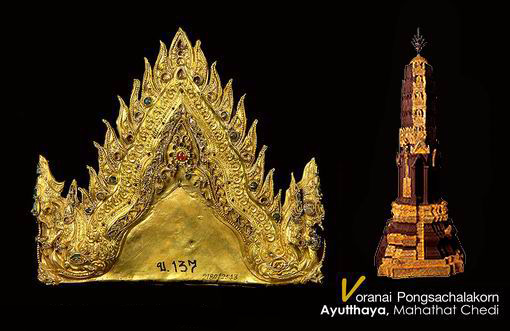
Bu (Beating/Covering) is shape beating to form desired shape for example figure of Lord Buddha. Shape beating will produce items that are much thinner than cast items. Compared to casting, smaller amount of gold yet greater level of craftsmanship is required for Bu . To cover outside or line inside an object with thin gold sheets can be referred to as Bu as well.
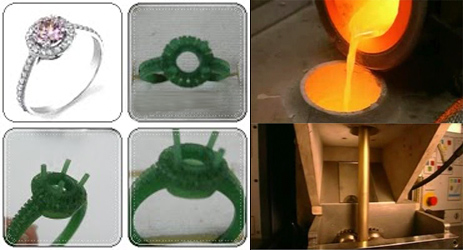
Lor (Casting) is a process by which a mold containing a hollow cavity of the desired shape is made, glowing melt gold is consequently poured into the mold and allowed to solidify, and then the cast piece is taken out of the mold and is finished to a complete item. Casting was often used to make highly regarded articles of significance for example, Buddha images, statues of deity and royal articles of use. To cast huge objects requires expertise of meticulous techniques to avoid cracks on gold surface. Moreover, casting normally uses greater amount of gold than shape beating Bu . Cast articles are averagely thicker and heavier than Bu items. To this day, it is hard to find Bu craftsmen while modernized casting has become widely available. As a result, objects used to be produced by Bu technique for instance dipping bowls, spittoons and kettles are alternatively made by casting.
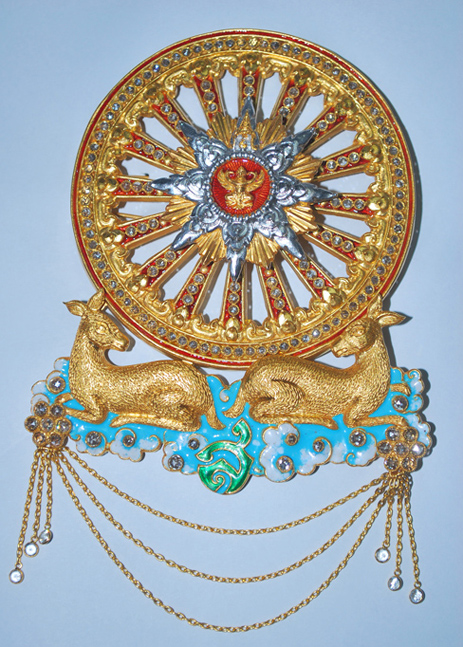
Sa-lak (Chasing) is done by hammering sharp-end punches on the front gold surface to obtain incised design. If the design's background is cut through like a fretwork, the technique is called Sha-lu (Perforating)
Khrum (Damascening) is the method of hammer-inlaying gold filament on non-precious metals such as iron or steel to produce a highly decorative pattern. The technique is employed to embellish blades of knives and scissors, sabres' ridges, handles of knives, scissors and sabres, scabbards of sabres and sheath of knives. (This craft is still practiced in Spain and Portugal to produce tools and jewellery. They called these pieces ‘Damascene' which indicates that Spain and Portugal got the craft from the Arabs).
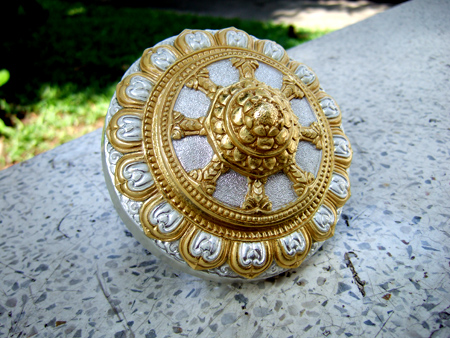
Pieakthong (Pure Gold Gilding) is a process by which fine gold is amalgamated with mercury; the liquefied gold is applied to metallic surfaces (mostly silver), and mercury is subsequently volatilized by heat. The gold coating will solidly bind to the piece and is much more durable than modern electroplating. If gilding is employed on some portions of an object only to accentuate patterns as usually done on Nielloware, the technique is specified as Ta-thong (Parcel-gilt). This particular type of Nielloware is named Thom-ta-thong .

Ga-lai (Gilding) is a method of coating metallic surfaces with precious metals including coating silver surface with gold and coating copper surface with silver, to obtain objects with golden or silvery surface. Ga-lai is more enduring than electroplating, too.
Thom (Niello) is a process of making incised pattern onto gold surface, filling it with black and thick liquefied niello amalgam, then filing to get a smooth and even surface. Black design on golden surface is obtained and the object is called Thomthong (Gold Nielloware). Only a small number of gold Nielloware was made and it is hard to find one (because of the high price of gold); mostly found were Thomngern (Silver Nielloware) and Thom-ta-thong (Silver Nielloware with Parcel-gilt). Sometimes Thomngern (Silver Nielloware) article that goes through gold gilding the whole item is allowed to be called Thomthong (Gold Nielloware) by its appearance. However, customers should be aware of such information. Like Damascening , Thailand got Thom craft from Portugal .
